
Whatever size garden you have or if you don't have one at all, each week Alan and his wife AKA Mrs Titchmarsh are showing how easy it is to grow your own at home.
Alan's team from Love your Garden, David Domoney, Katie Rushworth and Frances Tophill are all busy at work in their own gardens.

Filmed by their other halves the team gives us tips and growing ideas as well as a sneaky peek into their own gardens.
It is June and Summer has arrived and in the veg patch everything is growing fast.
The runner beans are getting bigger and ready to start twining up the poles.
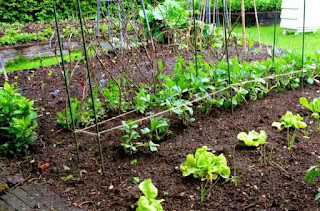
Carrots, Peas and Broad Beans are all doing well.
Now is a good time for planting Salads and Alan is making a planter in the garden for just them.
As his vegetable patch is already full he has a bought 1 metre square raised bed for them, which he fills with compost.

His aim is to show us how a small area can still look attractive growing lettuces.
Lettuces are low maintenance and easy to grow and the varieties he is putting in are Lollo Rosso and Butterhead.
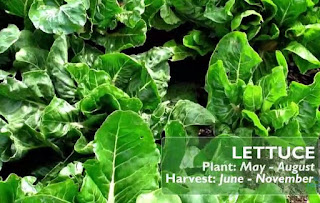
These can be grown from seeds or plug bought plants from May until August time and picked up to November.
Alan is planting them close together for effect but depending on how big you want them to grow depends on the spacing.
To stop them rotting make sure you don't plant them too deep but level with the soil.

Alan says once they reach 4 inches you can start picking the leaves, I usually like them small and tastier the better and of course they grow back.
Katie Rushworth is in Balidon, Yorkshire with her husband Andrew Edwards and their family.
She wants to grow her own but also save space so she is going to grow vertically!
On her wall she wants to create a vertical fruit and veg patch on a budget, as some living walls can prove to be quite expensive.

Katie has brought a kit off the internet that costs £40 for the starter kit which consists of 12 planting pockets.
The pockets are in rows of 3 planters and she is fixing batten to the wall to hang them from.
Katie starts with the bottom set of pockets that she fixes to the first batten, and the next pocket just stacks on it.
She has a total of 4 kits which she will put either side of her door.

As the planting pockets are quite small you have to make sure you use suitable plants.
Katie is planting hers with a mixture of herbs, flowers and edibles as she wants it to also look attractive as well as be functional.
She add Oregano, Bidens, Chocolate Peppermint and finally some strawberries.

Living walls do need a lot of watering, so at least once a day, and the flowers will need deadheading to keep them flowering.
Katie says 'it looks jazzy'.

If you are on a budget a fabric version costs about £3.50 and once filled with plants it will cover it.
Katie adds strawberries and tumbling tomatoes.

She loves them and as well as being partly edible, they do look good.
Good soil is needed for plants and vegetables to do well.
Organic matter helps retain moisture as well as adding nutrients to the soil.

We are talking Compost heaps!
You can buy soil enrichment but by using grass and plant clippings it will save you buying it.
Even a small garden can fit in a compost bin and the bigger the garden the bigger the bin.

A metre square is the ideal size and a good surround is needed, Alan shows us a shop bought one.
Things to put in the compost include vegetable waste, pruning from flowers, annual weeds, lawn cuttings potato peelings and egg shells.
Do not add meat. cooked food, bread, cooked vegetables, deep rooted weeds.

If it dries out to much in the hot weather, add water and keep it covered with old carpet or sacks to keep the heat in but stop it scorching.
Compost does take a few months to start but then its a continuous cycle and a good money saver.
Flashback for Alan to a very memorable compost heap in Wiltshire garden of Finn and Nicki.

Their amazing garden is helped by their huge compost pile which provides compost for the whole garden.
They are keen recyclers and love composting, even their relationship is compost!
Compost heaps produce heat and the hotter the better, for breaking down the raw materials.

The bacteria in his compost heap, with the help of grass clippings reaches 70C.
They stick in a thermometer probe to take the temperature at it is 65C.
Finn puts on some heat proof gloves and digs out some compost to get to the hot stuff, so hot it burns Alans hands!
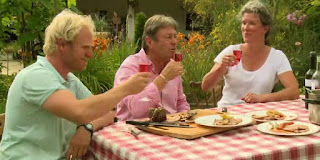
Finn pulls out a casserole dish, they can even cook in it and he has a brisket all cooked and ready to serve.
Alan joins them for some compost cooked brisket and a cheeky glass of wine in the garden.
Now for the Veg Trug challenge from Episode 2 when Alan gave them all a planter on legs to customise, to show all the different ways you can grow your own.
Katie is painting hers black, Frances is sawing hers and David has his children Alice, Abigail and Lance helping him.

It is video call time to look at each gardeners planter.

Alan has painted his Dove Grey and filled it with herbs so Mrs T does not have so far to go to get them from the kitchen.

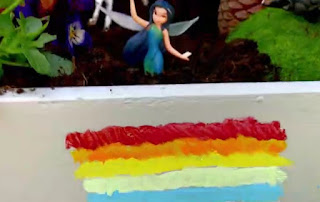
David and the children's planter is a wonderland garden landscape of fairies, ladybirds and all things magical including the NHS rainbow on the front.

Frances had problems getting the large planter in her garden so she cut it up and has painted it with a Wedgewood teacup design to grow tea related plants like Bergamot, lemon verbena, mint and Chamomile in.

Katie' planter is dark, moody and stormy! Painted black she has planted it with peppers, gooseberries, red kale, chillies, red lettuce.

And the winner is … David and the children, well it had to be!
David is at his home in Stratford upon Avon, Warwickshire that he shares with partner Adele Holdsworth and their 3 children.
He has been expanding his vegetable growing to feed his family during lockdown.

David is now planning ahead for Autumn and Winter as he wants to have crops for the whole year.
These will need more room than his raised beds so he is digging up some of the lawn!
He also has wild rabbits, who would just love his crops, so he is also putting a chicken wire fence round his new plot.

The ground under the turf he has removed is very hard and compacted!
Once dug over the first thing he is planting is Sweetcorn, which is too late for seeds but you can buy the plants and they need planting out in June to harvest September time.

David is planting them 30cm apart as they are a tall crop at 1.5 meters and you need more than 1 row for cross pollination.
Next its Pumpkins that need planting out in May or June to have pumpkins for Halloween in October time.
David plants them every year for the children and are easy to grow and you know when to harvest as they go the classic orange colour.

His tip for these thirsty plants is to also plant the pot next to the plant, so you can make sure the roots get a good water.
Brassicas are the final crop to be planted. Brassicas include cabbages, Brussel Sprouts and Cauliflowers in the family.
If you plant Brussel Sprouts in June they will be ready for your Christmas dinner in December.

Brussel sprouts grow up to a metre tall so they are planted half a metre apart, 50 cm.
David with a big smile on his face talks about Christmas day and picking the sprouts with his daughters ready for their dinner.
The final job is Pigeon and bird proofing the Brassicas by adding a tripod of canes and netting topped off with plant pots.

A good water in and the Big Veg plot is complete.
Alan tells us about good veg patch maintenance, keeping plants watered and hoeing out any weeds.
Frances has recently moved into a new terraced house in Folkestone, Kent with her partner and has been turning the small back yard into a productive garden.
This week she wants to add colour to her narrow backyard as well as helping her fruit and vegetables.

Flowers will attract pollinators as well as beneficial insects to her beds.
Single flowers are best for insects as they are easy to access to get to the pollen and nectar.
She is planting a calendula, which will help put off whitefly, which can ruin your tomato crop.

In the border she is planting French Marigolds a really good companion plant who colour range from yellow to burnt orange.
These are good with Sweetcorn, Beans and Brassicas as they help keep away a number of garden pests.
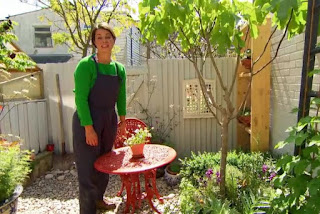
Edible flowers are also a good idea, like the beautiful Viola she is putting in a pot on her table.
They can be used in desserts, salads and drinks and Frances says they are delicious.
Pansies and Nasturtiums are also lovely and edible.

If your unsure its best not to eat anything out of the garden until you know it Is safe to eat.
The garden is now both pretty and edible.
Alan ends by sharing that growing your own, is about trying new things and enjoying it.

Whatever you grow, even if it is just a small patch, you will be rewarded with a fantastic edible treat.
'Just give it a go'.
These will need more room than his raised beds so he is digging up some of the lawn!
He also has wild rabbits, who would just love his crops, so he is also putting a chicken wire fence round his new plot.

The ground under the turf he has removed is very hard and compacted!
Once dug over the first thing he is planting is Sweetcorn, which is too late for seeds but you can buy the plants and they need planting out in June to harvest September time.

David is planting them 30cm apart as they are a tall crop at 1.5 meters and you need more than 1 row for cross pollination.
Next its Pumpkins that need planting out in May or June to have pumpkins for Halloween in October time.
David plants them every year for the children and are easy to grow and you know when to harvest as they go the classic orange colour.

His tip for these thirsty plants is to also plant the pot next to the plant, so you can make sure the roots get a good water.
Brassicas are the final crop to be planted. Brassicas include cabbages, Brussel Sprouts and Cauliflowers in the family.
If you plant Brussel Sprouts in June they will be ready for your Christmas dinner in December.

Brussel sprouts grow up to a metre tall so they are planted half a metre apart, 50 cm.
David with a big smile on his face talks about Christmas day and picking the sprouts with his daughters ready for their dinner.
The final job is Pigeon and bird proofing the Brassicas by adding a tripod of canes and netting topped off with plant pots.

A good water in and the Big Veg plot is complete.
Alan tells us about good veg patch maintenance, keeping plants watered and hoeing out any weeds.
Frances has recently moved into a new terraced house in Folkestone, Kent with her partner and has been turning the small back yard into a productive garden.
This week she wants to add colour to her narrow backyard as well as helping her fruit and vegetables.

Flowers will attract pollinators as well as beneficial insects to her beds.
Single flowers are best for insects as they are easy to access to get to the pollen and nectar.
She is planting a calendula, which will help put off whitefly, which can ruin your tomato crop.

In the border she is planting French Marigolds a really good companion plant who colour range from yellow to burnt orange.
These are good with Sweetcorn, Beans and Brassicas as they help keep away a number of garden pests.

Edible flowers are also a good idea, like the beautiful Viola she is putting in a pot on her table.
They can be used in desserts, salads and drinks and Frances says they are delicious.
Pansies and Nasturtiums are also lovely and edible.

If your unsure its best not to eat anything out of the garden until you know it Is safe to eat.
The garden is now both pretty and edible.
Alan ends by sharing that growing your own, is about trying new things and enjoying it.

Whatever you grow, even if it is just a small patch, you will be rewarded with a fantastic edible treat.
'Just give it a go'.
All photographs are copyright of ITV.com

No comments:
Post a Comment